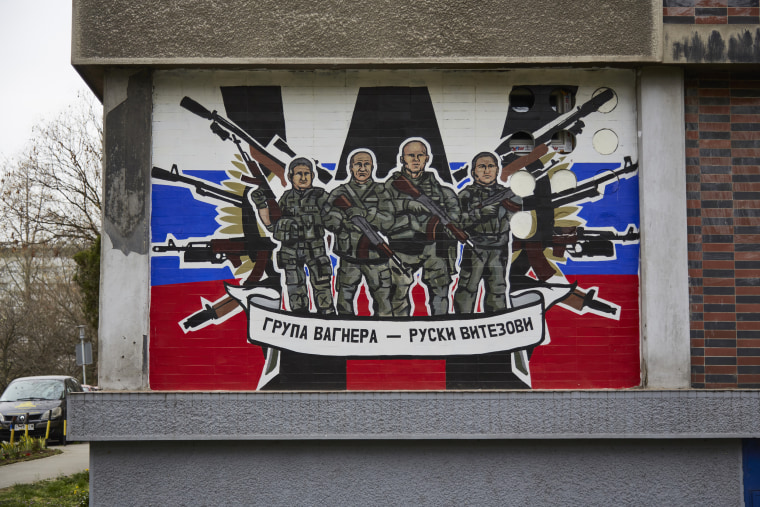Among Russian President Vladimir Putin’s many fantastical pretexts for invading Ukraine, the urgent need for its “denazification” may be the most preposterous. Ukraine isn’t free of domestic extremists, but Putin’s claims are pure disinformation. In fact, the Russian strongman has been supporting neo-Nazis and white supremacists for years, including mercenaries and separatists who have waged war on Ukraine since 2014.
Putin isn’t fighting neo-Nazism. He nurtures it, making his gaslighting about Ukraine even more repellent.
Putin has condoned and enabled a transnational white supremacist network that stretches around the globe. It’s one more instrument in the toolbox Moscow uses to divide democracies.
Perhaps Moscow’s most notorious military proxy is the Wagner Group, mercenaries the Kremlin has used to wage deniable war and otherwise promote its interests in places like Syria, Libya and Mozambique. Recently the Wagner Group deployed to the Central African Republic, and it has shown up in Mali, where its brutal methods appear to be replacing previous efforts by the international community to fight terrorists active in the country.
The Wagner Group is named after the 19th century German composer Richard Wagner, whose music Adolf Hitler adored. The group’s leader, Dmitry Utkin, reportedly wears Nazi tattoos, including a swastika, a Nazi eagle and SS lightning bolts. Wagner mercenaries are reported to have left behind neo-Nazi propaganda in the war zones where they’ve fought, including graffiti with hate symbols.
The Wagner Group also has played a key role in Putin’s long war on Ukraine, with its fighters helping him illegally annex Crimea in 2014 and fighting alongside pro-Russia separatists in the country’s east since then.
They’ve been active in the current hostilities, as well. The Daily Beast reported Jan. 31 that dozens of Wagner mercenaries were pulled from the Central African Republic to join Russian forces massing at the Ukraine border. And The Times of London reported that as many as 400 Wagner mercenaries may have been sent to Kyiv to attempt to assassinate or capture Ukrainian President Volodymyr Zelenskyy. Ukraine’s government has claimed that Zelenskyy has survived more than a dozen assassination attempts since the invasion began.
Then there’s the white supremacist group known as the Russian Imperial Movement, or RIM, which the State Department designated a terrorist organization in 2020 (an effort led by one of the authors here, Nathan Sales). With the Kremlin’s tacit approval, the group operates paramilitary camps near St. Petersburg in which neo-Nazis and white supremacists from across Europe are trained in terrorist tactics.
In 2016, RIM-trained terrorists conducted a series of bombings against a refugee shelter and other soft targets in Sweden, according to the State Department. Like the Wagner Group, RIM has deployed fighters to aid the Kremlin’s long-running war in eastern Ukraine. The group has supplied much-needed manpower, including people who are trained in asymmetric tactics and sabotage operations.
Russia uses neo-Nazi groups for much more than combat operations. Research by our organization — including a new report released Monday — shows that a key component of the Kremlin’s campaign to exploit fissures in the West is to use transnational white supremacists to promote racially and ethnically motivated violent extremism.
Myriad American neo-Nazi ideologues and operatives have traveled to Russia, as The New York Times reported in 2016, to attend networking conferences, illustrating the disturbing international links among this movement. Russia seems to welcome these figures with open arms. While the Kremlin has brutally suppressed civil society groups like those associated with pro-democracy activist Alexei Navalny, it has looked the other way on these white supremacists.
Russia is also serving as a refuge for extremists, with one of America’s most dangerous neo-Nazis finding sanctuary in the country. The BBC reported in 2020 that Rinaldo Nazzaro, the American leader of the white supremacist paramilitary group The Base, was living in Russia and directing the group from St. Petersburg. (Chatter on extremist online channels suggests Nazzaro may have stepped down from this role since Russia’s invasion of Ukraine, perhaps at the behest of his hosts.)
The FBI describes The Base as a “racially motivated violent extremist group” that “seeks to accelerate the downfall of the United States government, incite a race war, and establish a white ethno-state.” According to the BBC, a video put online in March 2019 “shows Nazzaro in Russia wearing a t-shirt bearing an image of President Vladimir Putin along with the words ‘Russia, absolute power.’”
Collectively, Putin has condoned and enabled a transnational white supremacist network that stretches around the globe. It’s one more instrument in the toolbox Moscow uses to divide democracies and undermine democratic institutions. Russia-backed white supremacists trade ideas and resources, both online and offline, to empower like-minded partners around the world.
The U.S. and its allies must take decisive action to challenge these toxic ideas and counter the operatives who embrace them. As for Putin, he has picked a side in the fight against the Nazis’ modern-day successors, and it isn’t ours.
